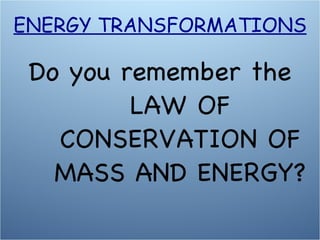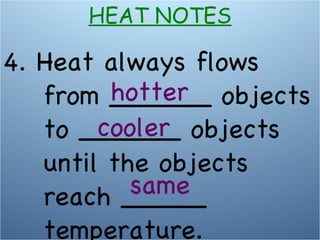Energy3
- 1. ENERGY
- 2. What is ENERGY? Energy is the ability to do _______ Work
- 3. Work occurs when a _____ causes an object to _____ in the same direction as the force. move force
- 5. DO NOW: Page 25 in Do Now packet that was given out yesterday
- 6. All forms of energy can be classified as Kinetic or potential. The two basic states of energy. So, what’s the difference?
- 10. 1) Potential energy is stored energy due to and object’s _____________ Position POTENTIAL ENERGY
- 11. 2) An object that is lifted from its position on Earth has __________ potential Energy which depends on ______ and mass gravitational POTENTIAL ENERGY height
- 12. 3) Massive objects have _____ potential energy than less massive objects more POTENTIAL ENERGY
- 13. 4) An object at a higher elevation will have _____ potential energy than an object at a lower elevation more POTENTIAL ENERGY
- 14. Kinetic is energy of ___________ Motion KINETIC ENERGY
- 15. 2) Kinetic depends on the _____ and the _______ of an object. MASS KINETIC ENERGY SPEED
- 16. 3) Faster objects have ____ kinetic energy than slower objects. More KINETIC ENERGY
- 17. FORMS OF ENERGY Both basic states of energy, Kinetic and potential, can exist in many forms!
- 18. The total ________ energy of the particles in matter. (molecular motion) Kinetic THERMAL (HEAT)
- 19. Heat energy STORED within the _____. Ex: Volcanic eruptions, geysers Earth GEOTHERMAL (HEAT)
- 20. Energy STORED in chemical ____ that can be released. Ex: food, fossil fuels, battery acid bonds CHEMICAL
- 21. Energy STORED in the ________ (center) of an atom . Ex: nuclear bombs nucleus NUCLEAR
- 22. Energy with which ______ objects perform work. Ex: Wind, flowing water, using a hammer moving MECHANICAL
- 23. A type of mechanical energy. It is the energy produced when objects ________. Ex: tuning fork, bell vibrate SOUND
- 24. A form of _______ energy that moves in a ______. Ex: lamp, stars radiant LIGHT wave
- 25. A form of energy produced by the ________ of ________ movement ELECTRICITY electrons
- 26. All forms of energy that come from the ______. SUN SOLAR ENERGY
- 27. Stored energy due to a change in the shape of an object. Ex: _______________ A stretched rubber band STORED MECHANICAL ENERGY:
- 29. Do you remember the LAW OF CONSERVATION OF MASS AND ENERGY? ENERGY TRANSFORMATIONS
- 30. Law of Conservation of ENERGY: (same for mass) Mass/ NRG ____________ Mass/ NRG ______________ Mass/ Energy can only __________ Can’t be made Can’t be destroyed Change form!!!
- 31. Please read the paragraph… Energy is constantly changing form… ENERGY TRANSFORMATIONS
- 33. Very often during the energy transformation process, some ____ energy is produced due to friction. This is wasted energy and is lost to the environment. heat UNUSABLE ENERGY:
- 34. An energy resource that is _______________________________________ . Being used faster than Earth Produces it What is a NON-RENEWABLE RESOURCE?
- 35. Examples: __________________ Fossil Fuels, minerals What is a NON-RENEWABLE RESOURCE?
- 36. To make our non-renewable resources last longer we can _____________________________________________ . Reduce Reuse Recycle What is a NON-RENEWABLE RESOURCE?
- 37. An energy resource that is _______________________________________ . Earth supplies faster than we use it “unlimited” What is a RENEWABLE RESOURCE?
- 38. Examples: _______________________________ Solar, wind, biomass (trees etc..) What is a RENEWABLE RESOURCE?
- 39. A renewable resource produces less _________ (substance that can harm living things and/or the environment pollution What is a RENEWABLE RESOURCE?
- 40. EARTH DAY GALLERY TOUR!
- 42. Example:
- 43. Do Now: Focused Free Write What is different about how each of the three popcorns? How were they made? Explain!
- 44. 1. HEAT: the energy of moving __________ particles HEAT NOTES
- 45. 2. HOT OBJECTS contain __________ heat than than cold ones more HEAT NOTES
- 46. 3. All objects above __________ contain heat Absolute zero HEAT NOTES
- 47. 4. Heat always flows from ______ objects to ______ objects until the objects reach _____ temperature. hotter HEAT NOTES cooler same
- 48. 4. The greater the difference in temperature between the two objects, the _________ heat is transferred. faster HEAT NOTES
- 49. HOW IS HEAT TRANSFERRED BETWEEN OBJECTS?
- 50. -Conduction is a form of heat transfer by direct _______ of molecules contact 1) CONDUCTION
- 51. -Conduction occurs fastest in _______ solids 1) CONDUCTION
- 52. -_______ are the best conductors of he heat energy. metals 1) CONDUCTION
- 53. -Convection is a form of heat transfer that occurs by up and down motions of a _______ differences in ______ fluid 2) CONVECTION density
- 54. -occurs ONLY in _____ which are liquids and gases! fluids 2) CONVECTION
- 55. -radiation is the transfer of heat in _____. waves 3) RADIATION
- 56. -Electromagnetic radiation travels at the speed of ______. light 3) RADIATION
- 57. -Electromagnetic energy can travel though a _______ (empty space) vacuum 3) RADIATION
























































